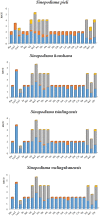Comparative mitochondrial genomes of four species of Sinopodisma and phylogenetic implications (Orthoptera, Melanoplinae)
- PMID: 33013166
- PMCID: PMC7515930
- DOI: 10.3897/zookeys.969.49278
Comparative mitochondrial genomes of four species of Sinopodisma and phylogenetic implications (Orthoptera, Melanoplinae)
Abstract
In this study, the whole mitochondrial genomes (mitogenomes) from four species were sequenced. The complete mitochondrial genomes of Sinopodisma pieli, S. houshana, S. qinlingensis, and S. wulingshanensis are 15,857 bp, 15,818 bp, 15,843 bp, and 15,872 bp in size, respectively. The 13 protein-coding genes (PCGs) begin with typical ATN codons, except for COXI in S. qinlingensis, which begins with ACC. The highest A+T content in all the sequenced orthopteran mitogenomes is 76.8% (S. qinlingensis), followed by 76.5% (S. wulingshanensis), 76.4% (S. pieli) and 76.4% (S. houshana) (measured on the major strand). The long polythymine stretches (T-stretch) in the A+T-rich region of the four species are not adjacent to the trnI locus but are inside the stem-loop sequences on the major strand. Moreover, several repeated elements are found in the A+T-rich region of the four species. Phylogenetic analysis based on 53 mitochondrial genomes using Bayesian Inference (BI) and Maximum Likelihood (ML) revealed that Melanoplinae (Podismini) was a monophyletic group; however, the monophyly of Sinopodisma was not supported. These data will provide important information for a better understanding of the phylogenetic relationship of Melanoplinae.
Keywords: Sinopodisma; mitogenome; phylogeny.
Qiu Zhongying, Chang Huihui, Yuan Hao, Huang Yuan, Lu Huimeng, Li Xia, Gou Xingchun.
Figures





Similar articles
-
The complete mitochondrial genome of the jumping grasshopper Sinopodisma pieli (Orthoptera: Acrididae) and the phylogenetic analysis of Melanoplinae.Zootaxa. 2017 Dec 12;4363(4):506-520. doi: 10.11646/zootaxa.4363.4.3. Zootaxa. 2017. PMID: 29245388
-
The complete mitochondrial genome of Sinopodisma hengshanica (Orthoptera: Acrididae) and its phylogenetic implication.Mitochondrial DNA B Resour. 2022 Apr 4;7(4):616-618. doi: 10.1080/23802359.2022.2060144. eCollection 2022. Mitochondrial DNA B Resour. 2022. PMID: 35402711 Free PMC article.
-
Characterization of the complete mitochondrial genomes of Cnaphalocrocis medinalis and Chilo suppressalis (Lepidoptera: Pyralidae).Int J Biol Sci. 2012;8(4):561-79. doi: 10.7150/ijbs.3540. Epub 2012 Apr 17. Int J Biol Sci. 2012. PMID: 22532789 Free PMC article.
-
Comparative Mitogenomic Analysis of Five Awl Skippers (Lepidoptera: Hesperiidae: Coeliadinae) and Their Phylogenetic Implications.Insects. 2021 Aug 23;12(8):757. doi: 10.3390/insects12080757. Insects. 2021. PMID: 34442323 Free PMC article.
-
Mitochondrial genomes of eight Scelimeninae species (Orthoptera) and their phylogenetic implications within Tetrigoidea.PeerJ. 2021 Feb 2;9:e10523. doi: 10.7717/peerj.10523. eCollection 2021. PeerJ. 2021. PMID: 33604160 Free PMC article.
Cited by
-
The complete mitochondrial genome of Phymateus saxosus (Coquerel, 1861) (Orthoptera: Pyrgomorphidae) and phylogenetic analysis.Mitochondrial DNA B Resour. 2024 Apr 4;9(4):457-460. doi: 10.1080/23802359.2024.2316064. eCollection 2024. Mitochondrial DNA B Resour. 2024. PMID: 38591051 Free PMC article.
-
Variation of the Tegmen and Cercus in Sinopodisma rostellocerca (Orthoptera: Acrididae: Melanoplinae) with Proposal of a New Synonym.Insects. 2024 Jul 12;15(7):526. doi: 10.3390/insects15070526. Insects. 2024. PMID: 39057259 Free PMC article.
-
Phylogenetics and Evolutionary Dynamics of Yunnan Acrididae Grasshoppers Inferred from 17 New Mitochondrial Genomes.Insects. 2025 Feb 3;16(2):151. doi: 10.3390/insects16020151. Insects. 2025. PMID: 40003781 Free PMC article.
-
Mitogenomic Comparison of the Mole Crickets Gryllotalpidae with the Phylogenetic Implications (Orthoptera: Ensifera).Insects. 2022 Oct 11;13(10):919. doi: 10.3390/insects13100919. Insects. 2022. PMID: 36292867 Free PMC article.
-
The Complete Mitogenomes of Three Grasshopper Species with Special Notes on the Phylogenetic Positions of Some Related Genera.Insects. 2023 Jan 13;14(1):85. doi: 10.3390/insects14010085. Insects. 2023. PMID: 36662013 Free PMC article.
References
-
- Cameron SL. (2014) How to sequence and annotate insect mitochondrial genomes for systematic and comparative genomics research. Systematic Entomology 39(3): 400–411. 10.1111/syen.12071 - DOI
-
- Chang H, Qiu Z, Yuan H, Wang X, Li X, Sun H, Guo X, Lu Y, Feng X, Majid M, Huang Y. (2020) Evolutionary rates of and selective constraints on the mitochondrial genomes of Orthoptera insects with different wing types. Molecular Phylogenetics and Evolution 145: 106734. 10.1016/j.ympev.2020.106734 - DOI - PubMed
-
- Chintauan-Marquier IC, Amédégnato C, Nichols RA, Pompanon F, Grandcolas P, Desutter-Grandcolas L. (2014) Inside the Melanoplinae: new molecular evidence for the evolutionary history of the Eurasian Podismini (Orthoptera:Acrididae). Molecular Phylogenetics and Evolution 71: 224–233. 10.1016/j.ympev.2013.09.009 - DOI - PubMed
LinkOut - more resources
Full Text Sources
